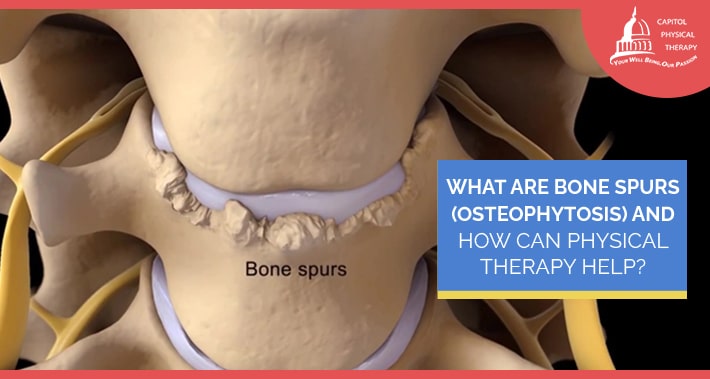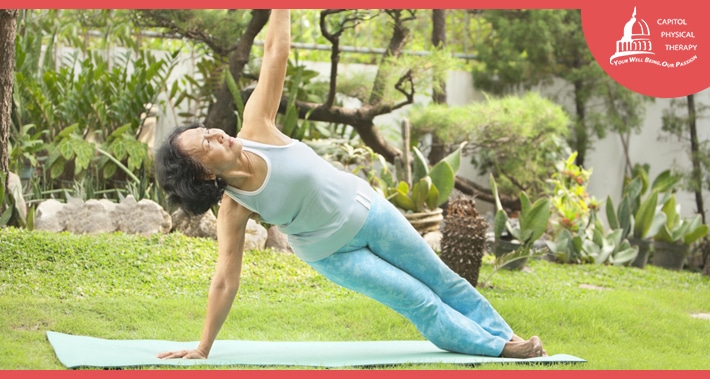
If you’ve ever noticed a smooth bump form on one of your bones, you might have a bone spur.
While the word “spur” might make you think of something sharp and painful, bone spurs often don’t hurt at all.
They can be nothing more than an aesthetic change in your body that doesn’t require any treatment.
But if you are experiencing pain and limited range of motion from a bone spur, our physical therapists can help get you feeling better.
But what exactly are bone spurs, how do they form, and how can orthopedic physical therapy help?
Let’s take a closer look.
What Are Bone Spurs?
When you hear the word spur, what comes to mind?
If you immediately think of what’s on the back of a cowboy’s boot, you’re not alone.
But despite the name, bone spurs aren’t actually sharp at all.
Instead, they’re smooth bumps or projections that stick out from your bones.
You can usually find them where two bones meet to form a joint, like at your heel, your knee, or on your fingers though they can also be in locations where muscles meet the bones.
Although it’s more common after the age of 60, anyone can develop bone spurs.
The scientific term for bone spurs is “osteophytosis.”
Bone spurs are visible through x ray imaging.
That’s typically how bone spurs are diagnosed.
X ray imaging is done by your primary care doctor, or an orthopedist.
RELATED: Healthy Seniors PT
Bone Spur Symptoms
Often, there won’t be any symptoms other than a bump that extends from your bone.
Usually bone spurs are small and aren’t painful, and most people don’t need treatment for their bone spurs.
However, if you develop bone spurs in your knee, shoulder, or hip, you may notice they’re painful and limit your movement in those joints.
A common spot to develop bone spurs is on your spine.
Bone spurs on your spine can be painful, but they can also press on your nerves and cause numbness in your arms, legs, and back.
RELATED: Physical Therapy For Spinal Issues
What Causes Bone Spurs?
It’s most common for bone spurs to occur in association with osteoarthritis
Osteoarthritis is the kind of arthritis that happens when you’ve had a lot of wear and tear on your joints over time.
Osteoarthritis is most common in seniors.
RELATED: Physical Therapy for Seniors Health
However, you can get it while you’re younger if you’ve had a sports or running injury, or if you were in a car accident or other injury.
Bone spurs are also associated with:
- Sports injuries
- Athletics with improper footwear
- Repetitive or high impact movements without aftercare (like stretching or using a foam roller)
How Can Bone Spurs Physical Therapy Help?
There is a misconception that there’s no way to remove a bone spur other than surgically, which isn’t usually necessary.
While that is a direct way to impact the bone spur, postural retraining, stretching or strengthening -depending what the causal factors of the bone spur are – could allow your body to remove the bone spur by reversing the processes it used to build it.
The good news is that physical therapy can help by providing chronic pain management and helping you to prevent the development of more bone spurs that could become painful.
No matter the cause, bone spurs are produced by your body in response to its environment.
Our Washington DC physical therapists can help you with methods that decrease the pressure on your joints so you’re less likely to continue to develop more bone spurs.

1. Pain Management
There are a few things your physical therapist might recommend to help with pain due to bone spurs.
Your physical therapist may recommend you use heat and cold therapy or dry needling.
Each of these options may help reduce the pain you feel in your bone spurs by helping to reduce excess pull on the bones from the muscles.
2. Strengthening Exercises
Since bone spurs can be caused by the bones in your joint rubbing together, an important part of treatment is strengthening the muscles around that joint.
Strengthening the muscles around an overly moveable, or hypermobile, joint can help it move better so your bones don’t rub together as much.
This decreases your pain and also reduces your chances of developing more bone spurs.
Your physical therapist will recommend exercise based on your needs, age, and activity level.
3. Posture And Gait Training
If you have poor posture overall or just related to a specific joint, it can cause bone spurs to develop.
Your physical therapist can work with you to create habits that will improve your posture and decrease the development of bone spurs.
This may include improving your workplace ergonomics and teaching proper lifting techniques.
Along with posture, sometimes you have to change an incorrect movement in a joint that is likely to lead to more bone spurs.
This might be in the way you walk, or in other movements.
Your physical therapist can help change poor joint motions into correct joint motions, which can reduce your pain and help make moving around easier.
RELATED: Gait Training Physical Therapy
4. Stretching Exercises
Your physical therapist may provide you with stretching exercises that focus on your affected joint.
Stretching can help loosen up the muscles around your joint which can ease pressure on your bone spur and decrease your pain.
Book Your Appointment With Capitol Physical Therapy Today
If you’re experiencing pain from bone spurs, it’s wise to seek help from a physical therapist in order to resolve your pain and prevent more bone spurs from developing.
We can help.
Book your appointment with Capitol Physical Therapy today.
1331 H St NW #200,
Washington, DC 20005
- https://g.page/capitolptdc
9560 Pennsylvania Ave. # 202,
Upper Marlboro, MD 20772
- https://goo.gl/maps/zjL4NnnuThRhrcS86
Capitol Physical Therapy offers orthopedic and other pain related solutions, with our versitile team of physical therapists in Washington, DC